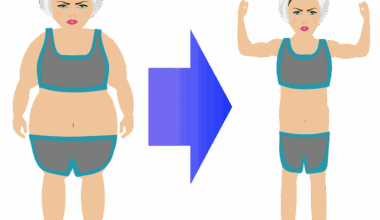Balancing Cardio and Strength in Solo Bootcamp Workouts
Engaging in solo bootcamp workouts demands a focused strategy to balance cardio and strength training effectively. Many fitness enthusiasts often lean towards one aspect, which can create imbalances in overall fitness. Effective workouts should incorporate both cardio exercises and strength training routines. Cardio helps improve heart health, endurance, and metabolism, while strength training builds muscle mass, enhances strength, and contributes to fat loss. The combination of both forms a comprehensive training regimen that promotes overall fitness. Transitioning between high-intensity cardio and strength sessions can be beneficial. For example, performing circuit training can blend both elements seamlessly. Consider alternating between bodyweight exercises and explosive cardio intervals to maximize calorie burn. Use a timer to structure intervals correctly, maintaining a pace that keeps heart rates elevated while also allowing for resistance exercises using weights or bands. Additionally, setting specific goals will help keep you motivated, such as completing a certain number of circuits per week. Consider documenting your progress to keep track of improvements and set new challenges. Overall, the balance of cardio and strength sustains engagement and promotes well-rounded fitness, ensuring progress toward your health objectives.
The choice of exercises in bootcamp workouts significantly influences how effectively both cardio and strength elements are integrated. One effective approach is utilizing compound exercises that work multiple muscle groups while raising the heart rate. Examples include squat to press, burpees, and kettlebell swings, which effectively burn calories while building muscle. Incorporating a mix of plyometrics, such as box jumps or jump squats, can also enhance the cardiovascular component while improving strength. It’s essential to customize the workout based on individual fitness levels. Beginners may need to focus on foundational moves before progressing to more intensive forms. As individuals adapt to routines, gradually increasing intensity keeps the workouts challenging and challenging enough to promote growth. Additionally, investing in resistance bands or dumbbells provides versatility in training. Whether at home or outdoors, resistance equipment can go a long way in diversifying training routines. The workout environment also influences performance; finding a location that inspires motivation can contribute to consistency. Create designated workout times and stick to them as much as possible, just like attending a class, which enhances adherence to workout programs and leads to better outcomes.
Creating an Effective Bootcamp Training Plan
To create an effective solo bootcamp training plan, a structured approach is crucial. Start by defining your fitness goals, whether it’s weight loss, muscle gain, or endurance improvement. Setting clear, measurable goals gives direction to the training program. Next, distribute your weekly sessions to encompass both cardio and strength routines evenly. For instance, a good weekly structure may include three days of strength training combined with two days of cardiovascular intervals. Each session should consist of a warm-up to prepare the body for exertion. This includes dynamic movements, ensuring muscles are ready and reducing injury risk. Following the warm-up, workouts should alternate between strength and cardio exercises. For example, perform 10 minutes of high-knees followed by 15 minutes of squats, deadlifts, or lunges. Cool down with stretches that target the key muscles used during workouts. Furthermore, rest days are essential to allow muscle recovery and prevent burnout. Incorporate light activities on rest days, like walking or yoga, to promote mobility and flexibility. Remaining accountable through self-assessment and adjustment of training plans leads to sustainable improvement in fitness levels.
Nutrition plays a significant role during any bootcamp-style training, as it fuels workouts and aids recovery. Consider following a balanced diet rich in lean proteins, whole grains, healthy fats, and plenty of fruits and vegetables. A well-rounded diet supports muscle recovery while providing energy for high-intensity training. Before workouts, consuming carbohydrates, such as oatmeal or bananas, offer quick energy for your sessions. Post-workout meals are equally important; incorporating protein helps repair and build muscles. Aim for meals that include sources of complete proteins, like grilled chicken, fish, or plant-based protein alternatives. Hydration cannot be overlooked, as staying adequately hydrated supports performance and recovery. Aim for at least eight glasses of water a day, but this may vary based on workout intensity and individual needs. Electrolytes may also be vital after longer sessions or intense workouts. Simple solutions, such as homemade electrolyte drinks or low-sugar sports drinks, can keep the body properly fueled. Listening to your body’s hunger and thirst cues is fundamental. Ultimately, balancing cardio and strength training in solo bootcamp workouts necessitates proper nutrition alongside exercise regimens.
Tracking Progress in Your Workouts
Monitoring progress in solo bootcamp workouts builds confidence and motivates continued improvement. Using a fitness journal or mobile app can assist in tracking workouts, noting exercises performed, sets, and repetitions. Evaluate performance over time to identify strengths and areas requiring improvement. Many find it beneficial to take photos or measurements to document physical changes when working towards personal fitness goals. Such visual records are powerful indicators of progress, often more encouraging than just seeing numbers on a scale. Daily workouts should aim to be progressively challenging; hence, maintain notes on how you felt during exercises can help encourage adjustments in workout intensity. Revisiting workouts and comparing notes can showcase remarkable improvements in stamina or strength. Additionally, consider joining online fitness communities or forums for accountability and motivational sharing; discussing experiences and results with others helps boost your commitment. Seeking professional advice from fitness trainers or joining various fitness classes also aids your training diversity. Consider altering the workout routine every few weeks or increasing weights to sustain positive changes. For individuals who enjoy challenges, participating in local fitness events or competitions can further motivate regular participation.
Utilizing technology can enhance your solo bootcamp training experience dramatically, particularly through apps and wearables that provide insights into performance. Many fitness apps offer guided workouts, tracking capabilities, and forums to connect with others pursuing similar goals. These tools often include options to schedule reminders, ensuring consistency. Measuring heart rate during workouts gives immediate feedback, optimizing calorie burn and workout effectiveness. Smartwatches and fitness bands provide valuable statistics such as steps taken, calories burned, and active minutes, allowing for personal adjustments over time. Some apps even offer interactive challenges or progress benchmarks, keeping training engaging and enjoyable. Supplementing workout sessions with video tutorials can clarify complex movements or enhance technical skills essential for performing exercises correctly. Online platforms ranging from YouTube to specialized fitness channels broaden access to knowledge and training styles. Such resources can boost confidence in executing new routines or exercises effectively and safely. Embracing technology allows for diversity in workouts that can continuously inspire motivation. Utilize this wealth of online information to enhance individual understanding of health and wellness. Overall, maximizing technology enriches solo bootcamp experiences while helping achieve fitness goals.
Finally, to sustain engagement in solo bootcamp training, establishing a community support system can prove invaluable. Connecting with friends or family members for mutual support or accountability often fosters a friendly competitive spirit. Use social media to follow fitness influencers or local bootcamp groups, ensuring a steady stream of inspiration and motivation. Participating in group challenges can elevate the experience by combining efforts with like-minded individuals, creating an environment of mutual encouragement. Consider documenting and sharing your journey on social media platforms, showcasing progress, insights, or workout highlights. Highlighting personal achievements not only tracks your growth but motivates others. Having an online community can also encourage the sharing of tips, workouts, and nutrition advice, enhancing overall engagement and keeping motivation high. If possible, consider joining local bootcamp sessions or group classes for a change of pace and interaction. Engaging with trainers or fellow attendees can help broaden knowledge and introduce new challenges. Surround yourself with individuals who share similar fitness goals, fostering a positive environment for growth while keeping the workouts enjoyable. Ultimately, finding balance in cardio and strength through engagement solidifies long-term fitness achievements.


